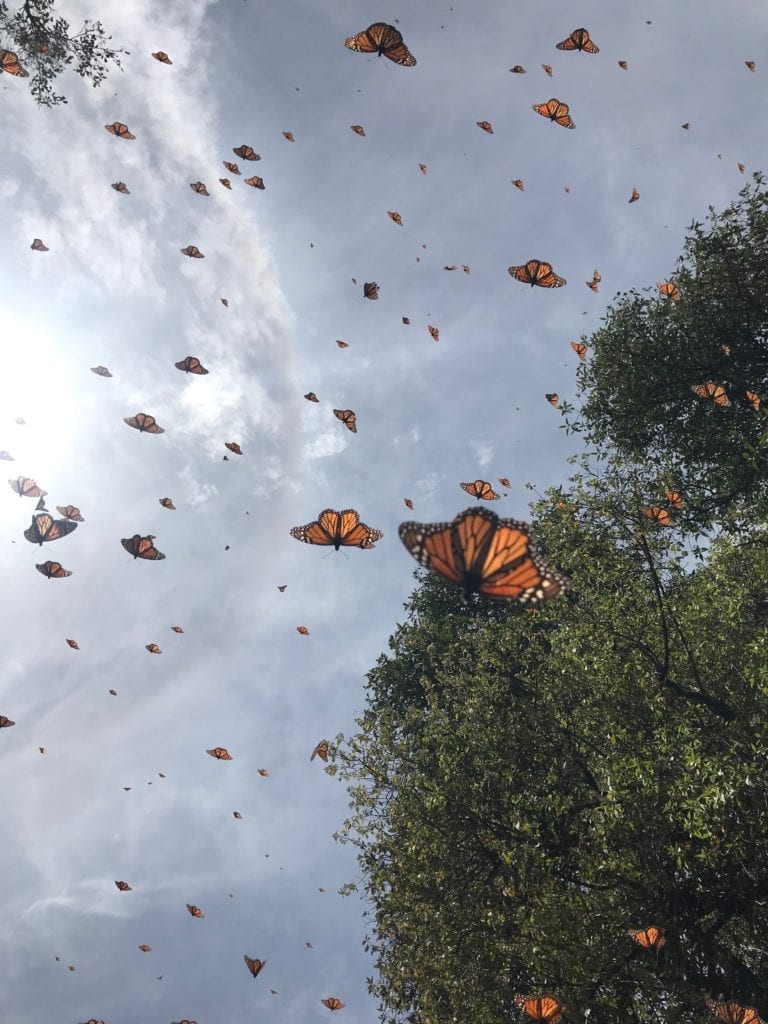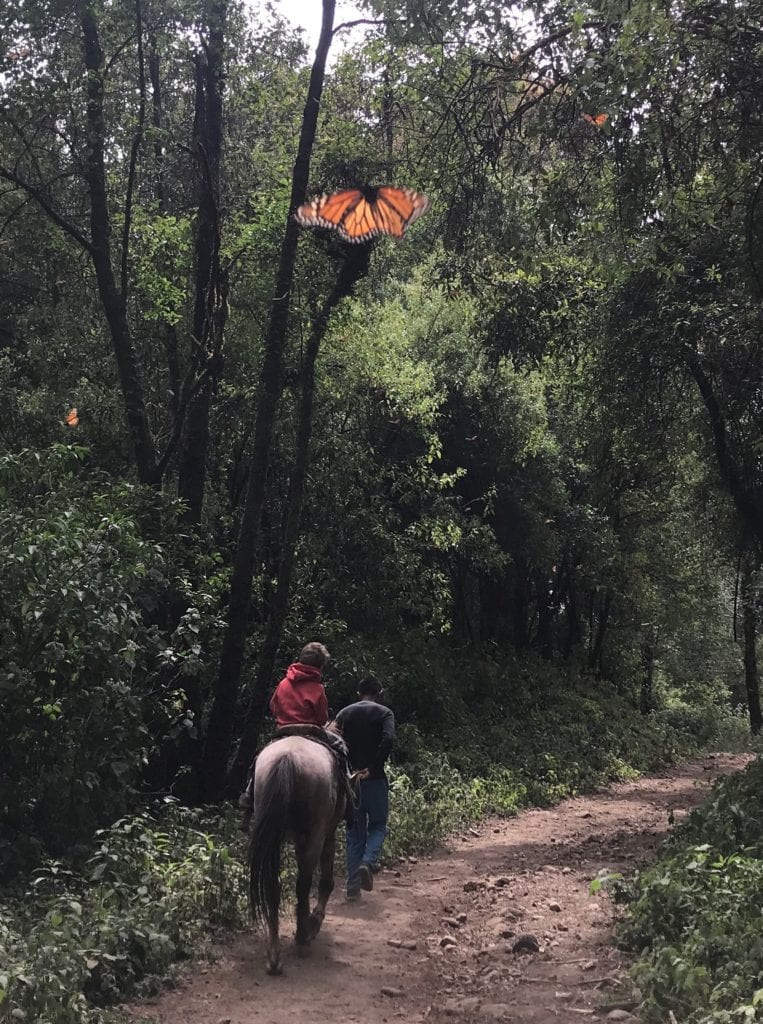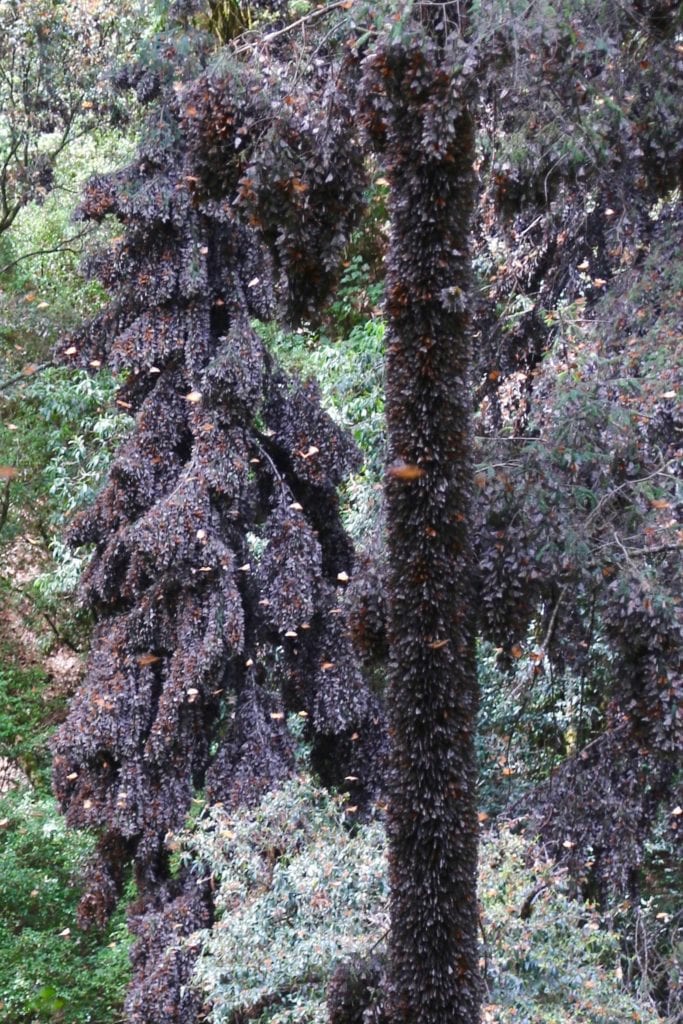
This is Part 2 of the Lambert family sojourn to Mexico in pursuit of Monarch butterflies. Read Part 1 here.
An Intergenerational Quest
In the fall, monarchs across the eastern United State and Canada migrate to a plot of fir trees in the mountains of Mexico last visited by their great great grandparents. How do they know where to go? Scientists have no idea (though they suspect they may use the sun and Earth’s magnetic field as a compass1). In late February or March these same monarchs, now living in the mountains in Mexico, begin to migrate north and reproduce. Their offspring continue the journey north, following the proliferation of milkweed. It takes four or five generations of butterflies to complete the cycle, flying north and reproducing. The fifth generation, emerging in late summer, flies south, beginning the cycle anew.
This cycle of five generations in a year makes death appear as one more stage in transformation. As if a monarch goes from egg to caterpillar to chrysalis to butterfly to death and around again five times around the wheel, all the while completing its magnificent journey north and south. This gives me hope that the current chapter of my own small life is a part of something unfathomably larger than I can know.
In his poem A Vision, Wendell Berry writes:
If we will have the wisdom to survive,
to stand like slow-growing trees
on a ruined place, renewing, enriching it…
then a long time after we are dead
the lives our lives prepare will live
here, their houses strongly placed
upon the valley sides, fields and gardens
rich in the windows. The river will run
clear, as we will never know it,
and over it, birdsong like a canopy…
On the steeps where greed and ignorance cut down
the old forest, an old forest will stand,
its rich leaf-fall drifting on its roots.
The veins of forgotten springs will have opened.
Families will be singing in the fields.
In their voices they will hear a music
risen out of the ground….
Memory,
native to this valley, will spread over it
like a grove, and memory will grow
into legend, legend into song, song
into sacrament. The abundance of this place,
the songs of its people and its birds,
will be health and wisdom and indwelling
light. This is no paradisal dream.
Its hardship is its possibility
As each of us transforms in the work that transforms our world, I learn from the monarchs – it is the lives our lives prepare that will enjoy the fruits of our labors – we will be memory, legend, and song for future generations.
The last generation of monarchs, emerging in late summer, flies all the way to Mexico – three thousand miles!
As our family made the same journey, the six-hour flight from Boston to Mexico City seemed interminable. Granted, I had a wriggly one-year old on my lap. But we flew at five hundred miles per hour, and I never had to lift a wing!
I’ve seen monarchs passing through Casco Bay on migration. They appear aimless, wafting one direction, drifting the other, fluttering gently up and down on the breeze, sipping nectar here and there. And yet somehow they can fly twenty miles an hour2! Perhaps my own zigzag through life will have the same meaningful trajectory? I can only hope.
It is one thing to know theoretically that monarchs make this journey, and another entirely to wander up a dusty trail in the state of Michoacán, and remember that these monarchs – the very same! – flew all the way from the Northeast or even Canada. I feel a kinship with my fellow travelers, coming all this way on pilgrimage. It is such a long quest.
All along their lengthy journey, the butterflies give back to the Earth, gathering pollen as they sip nectar, sipping nectar as they gather pollen, gifting it to the next flower they touch. I hope the monarchs can teach me how delving into what nourishes me most can help me give back to Earth, too – not out of guilt, but out of love.

Gathering of All Souls
The monarchs arrive in Zitácuaro on November 1, All Souls Day. The locals call them palomitas de los Santos, little doves of the Saints. In the villages, they flutter in ones and twos, tributaries to a flood up in the mountains. Walking up the dusty trail, the tributaries became a river, and I lie on my back to watch the cascade of monarchs flow overhead. Staring up at them, I am light and giddy as though I too were air born, my heart lifted high on ten thousand perfect wings.
Metamorphosis can feel so lonely, entering the terrifying unknown hanging from silken threads far from others of your kind. But the gathering of all souls is anything but. Here you can witness how many millions are like you – millions of orange wings, light and whole, through so many generations, having completed the improbable transformation and precarious journey to this Mecca in Mexico.
Further up the mountain, the monarchs gather on trees. First, we notice a single trunk entirely covered in monarchs. As our minds try to make sense of this, the background resolves: entire trees are nothing but butterflies, their weight bending the bows, not a leaf nor needle to be seen beneath their folded wings. A disturbance lifts a great orange cloud into the valley.
A sign advises us to be quiet. Staring in awe, I whisper to my friend that I heard the monarchs congregate like this for warmth. Lonely from recent heartbreak, she sighs wistfully, as if ready to nestle amongst all those soft wings and fluttering hearts.

Human Pupils (pupas?)
When my father died unexpectedly nearly five years ago, people converged on his home in Falmouth the way monarchs converge in the mountains of Mexico, as if answering some inner call. Among the furthest traveled was a man named Rodolfo Ogarrio, a friend of my father’s from Mexico. In the midst of our grief, Rodolfo and I bonded over our love for my father, as well as our love for monarchs.
It was on Rodolfo’s invitation that we traveled to Mexico to see the butterflies. We could not have asked for a better host and guide. Someday I hope Rodolfo will share his story, but suffice to say that from the day he first set foot among the monarchs, he worked tirelessly for ten years to protect their forests. Finally the government of Mexico agreed to protect the area, and the land is now a Biosphere Reserve. Without the work of Rodolfo and others like him, we would no longer see monarchs on our milkweed here in Maine. There would be no eastern migration.
After a couple of years of raising monarchs with my kids, I wanted to do more for the butterflies too, so I reached out to the City of Portland parks director, who put me in touch with Maine Audubon. I provided some seed money (literally and figuratively), and Audubon worked with the City and King Middle School students to put a monarch garden on the Western Prom, just a short walk from my house.
The kids book A Monarch Butterfly Story by Melissa Kim, published in cooperation with Maine Audubon, tells a similar story: Maine kids planting monarch gardens to support the monarchs and their migration. Maine Audubon generously provided us with copies of A Monarch Butterfly Story and other resources to share with the Mexican communities near the butterflies.
While human champions do their part, monarchs are the true teachers; it is up to us to learn from them. The environmental challenges we face demand cultural metamorphosis, and a culture only transforms as individuals answer the call to change. We’ll do our best to give the monarchs a second chance, as they give us a second chance. The monarchs show us the way.
